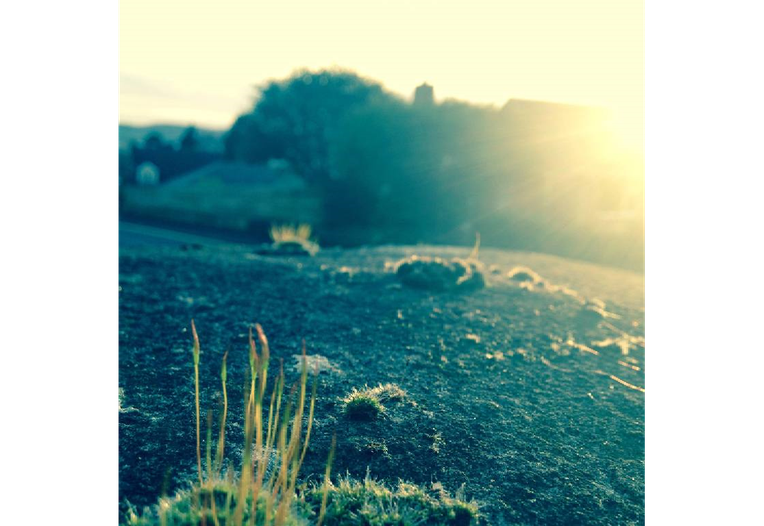Relationships
From the Series: Lexicon for an Anthropocene Yet Unseen
From the Series: Lexicon for an Anthropocene Yet Unseen

To speak about Indigenous people’s relationships to land, water, law, language, history, and futures, it is important that I first foreground my statements by telling you who I am and where I am from so that you can situate how and why I know what I know. My name is Zoe Todd. I am an otipemisiw iskwew—a Métis woman—from amiskwaciwâskahikan, in Treaty Six Territory in Alberta, Canada. My ancestors are Red River Métis on my dad’s side of the family, and my Mom’s family are British-Norwegian settler-Canadians. Both kinship and place situate the thoughts I have to offer on the interrelatedness of people, place, stories, and time in the Anthropocene.
I come from Alberta; if you have heard of it at all, you probably know it as the home of the Tar Sands. In my short lifetime I have watched the waterways of my home province deteriorate as intense oil and gas activity, urban development, agricultural demands, and climate change tighten, vise-like, on rivers and creeks and kettle lakes and glacier-fed watersheds.

The Anthropocene is what Elizabeth Reddy calls a “charismatic mega-category,” which sweeps up within it the diverse, dynamic, and even contradictory discourses of peoples throughout the globe contending with catastrophic environmental change. In discussing the Anthropocene, I am continuously brought back to the inextricable relationships between land, bodies, time, and stories—relationships I continue to learn more about as I apprentice in the study of Indigenous legal orders and Métis philosophy here in North America.
At the 2015 American Anthropological Association meetings in Denver, panelists in the “Force and Power in the Anthropocene” session offered provocative accounts of the impacts and implications of the environmental change that is being observed around the globe. As I listened to the narratives offered by the panelists, I considered how their words mingled with the land and stories of this place. I was reminded of the way in which Cree legal scholar Tracey Lindberg recently opened a talk in Ottawa, Canada, by reminding interlocutors to consider our duties to the Algonquin ancestors of the place where we stood—whose bones are ground into the earth we walk on. These ancestors, too, bear witness to our deliberations.
Listening to the stories about plants and plastic, melting ice and movement that were shared during this session, I wondered: What does it mean to have a reciprocal discourse on catastrophic end times and apocalyptic environmental change in a place where, over the last five hundred years, Indigenous peoples faced (and face) the end of worlds with the violent incursion of colonial ideologies and actions? What does it mean to hold, in simultaneous tension, stories of the Anthropocene in the past, present, and future?
Climate scientists Simon Lewis and Mark Maslin (2015) argue that the beginning of the Anthropocene is, quite possibly, rooted in the environmental impacts of the genocide of fifty million Indigenous peoples throughout the Americas, following Christopher Columbus’s “discovery” of America. Lewis and Maslin argue that the movement of species between the Old and New Worlds after 1492, as well as the precipitous decline in agriculture and land-tending due to the rapid loss of Indigenous lives, resulted in a measurable increase in forest cover, leading to a dip in carbon dioxide levels around the globe. They propose that one Anthropocenic “golden spike,” labeled the Orbis Spike, can be placed in the year 1610. The machinations of wide-scale anthropogenic environmental change instigated by European colonization of the Americas—and the subsequent meteoric rise of a global capitalist system that was fueled by resources mined, hewed, and drawn from colonies, often through slave and/or indentured labor—are now, arguably, catching up with the entire globe. If Lewis and Maslin’s Orbis Spike hypothesis is correct, then this compels humanity to tend to the interconnections between, first, Indigenous genocide and the violent enslavement of peoples from across Africa, the Pacific, Asia, and the Americas throughout the colonial period, and second, the contemporary economic, political, social, and cultural forces shaping current environmental and power relations.
Indigenous scholar Cutcha Risling Baldy discusses how she uses the zombie television show The Walking Dead in her teaching to discuss what it was like for Indigenous peoples in the United States to contend with the end of worlds—the apocalypse—at the hands of Spanish, British, and American empire. During the pop-up panel in Denver, Timothy Morton urged us to dream; it is pertinent here to point out that Indigenous people have been dreaming of an otherwise since the incursion of violent colonial ideologies, language, and laws into sovereign Indigenous territories in the Americas. And, crucially, as Cutcha Risling Baldy points out, Indigenous peoples are still here. Still telling stories. Still insistent, present, self-determining, and strong.
So what lessons can we learn from resurgent, resistant, resolute, and still-living Indigenous peoples who have already faced the upheaval wrought by the early forces of the Anthropocene? In my home territory, the principles of loving accountability and reciprocity are deeply embedded in Indigenous legal orders and relationships. What I have learned from these teachings, from mentors like Tracey Lindberg and Cree legal scholar Val Napoleon, is that reciprocity, love, accountability, and care are tools we require to face uncertain futures and the end of worlds as we know them. Indeed, this ability to face the past, present, and future with care—tending to relationships between people, place, and stories—will be crucial as we face the challenges of the Anthropocene, collectively, in our nations/societies/peoples, and in communities around the globe.
Ay-ay.
Lewis, Simon L., and Mark A. Maslin. 2015. “Defining the Anthropocene.” Nature 519: 171–180.